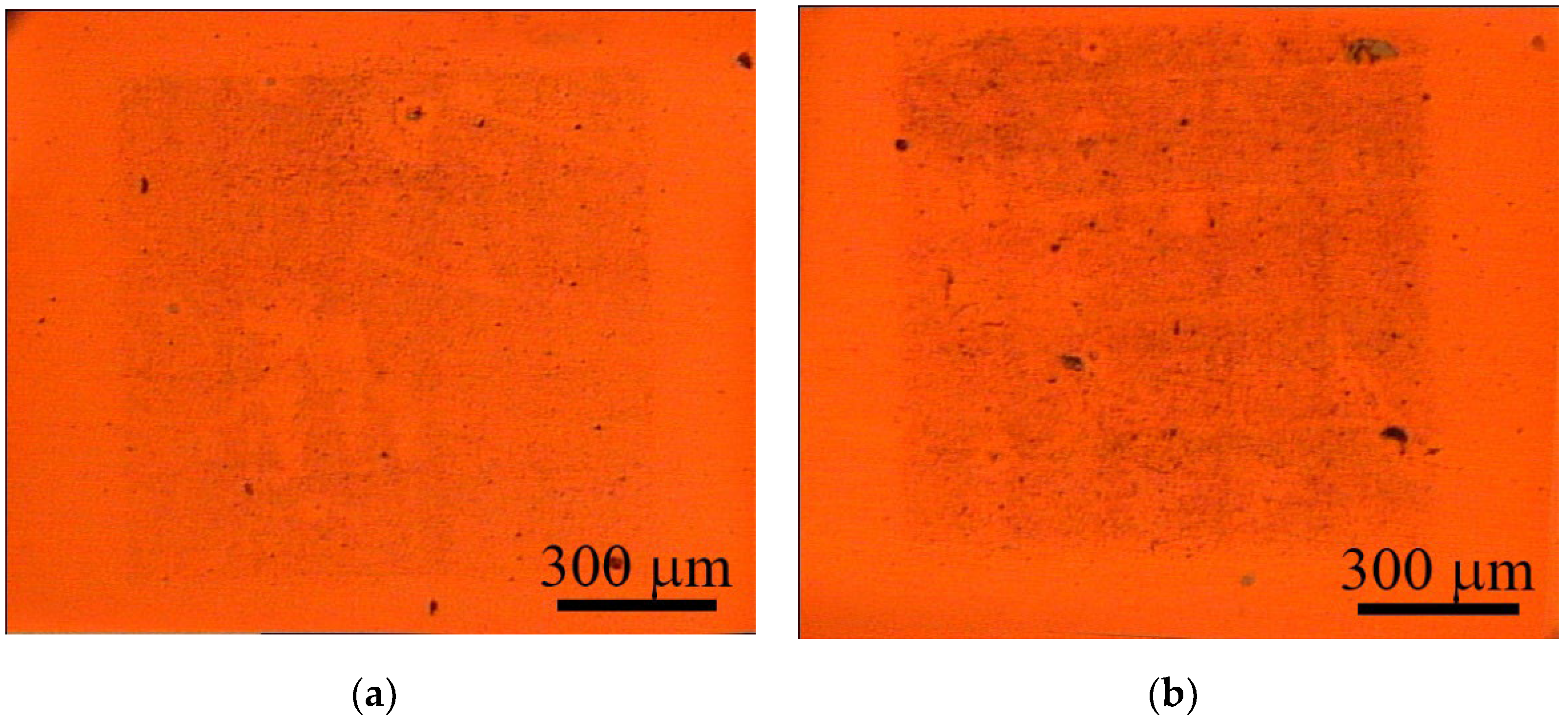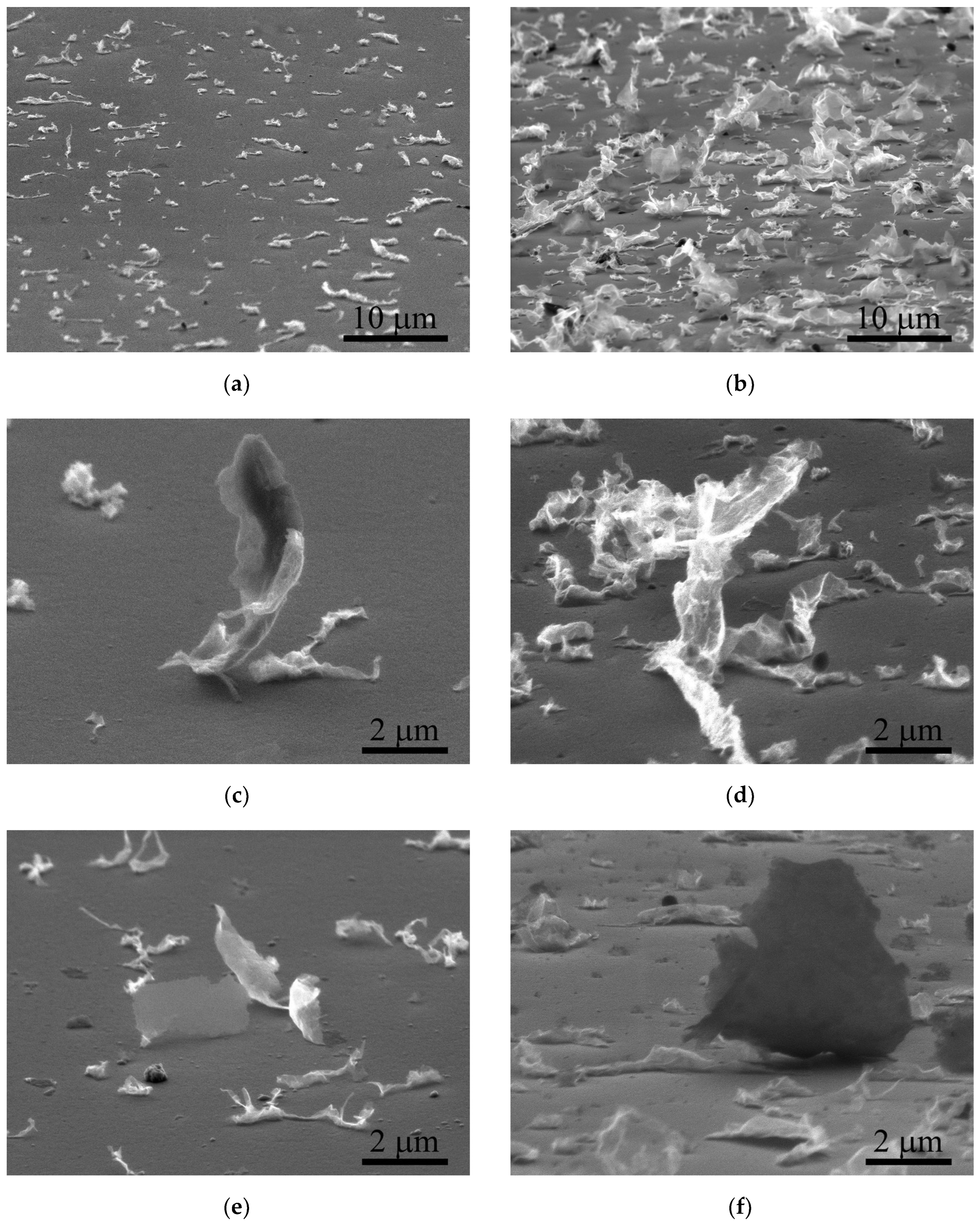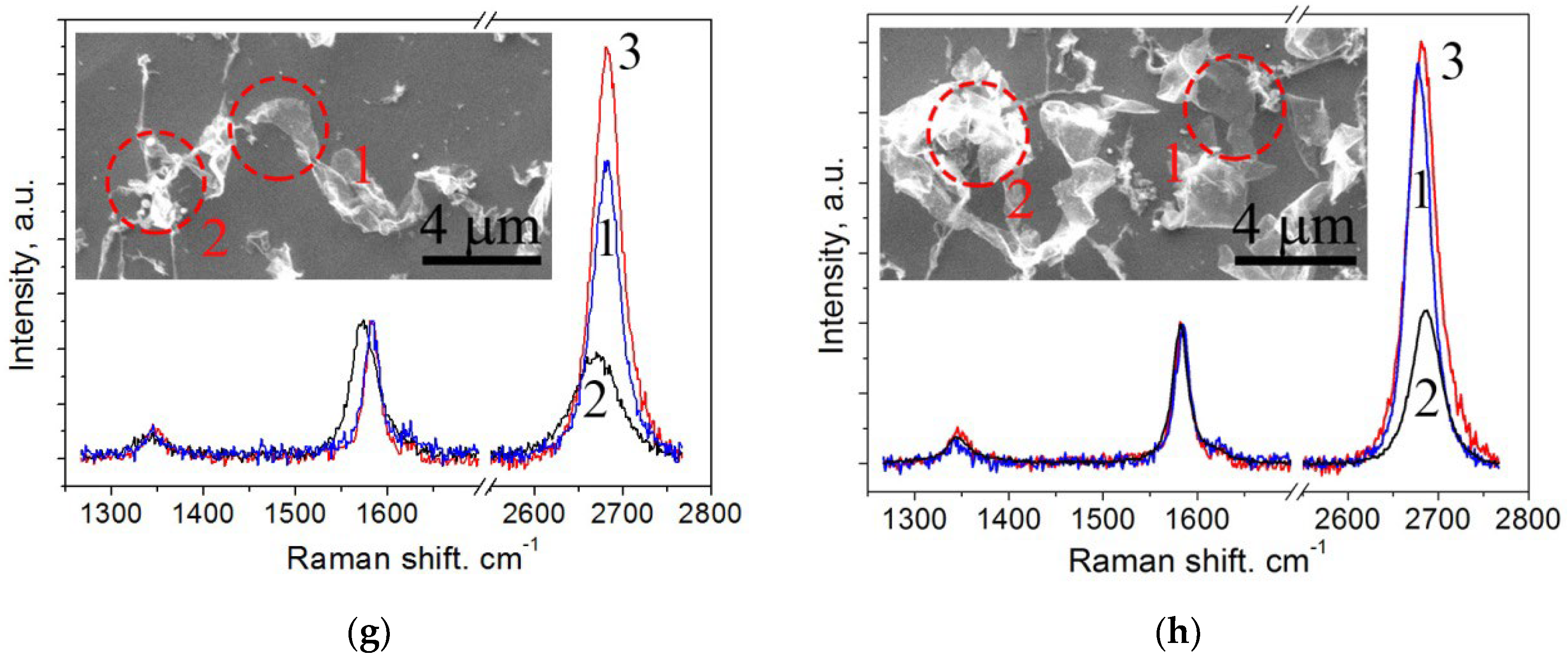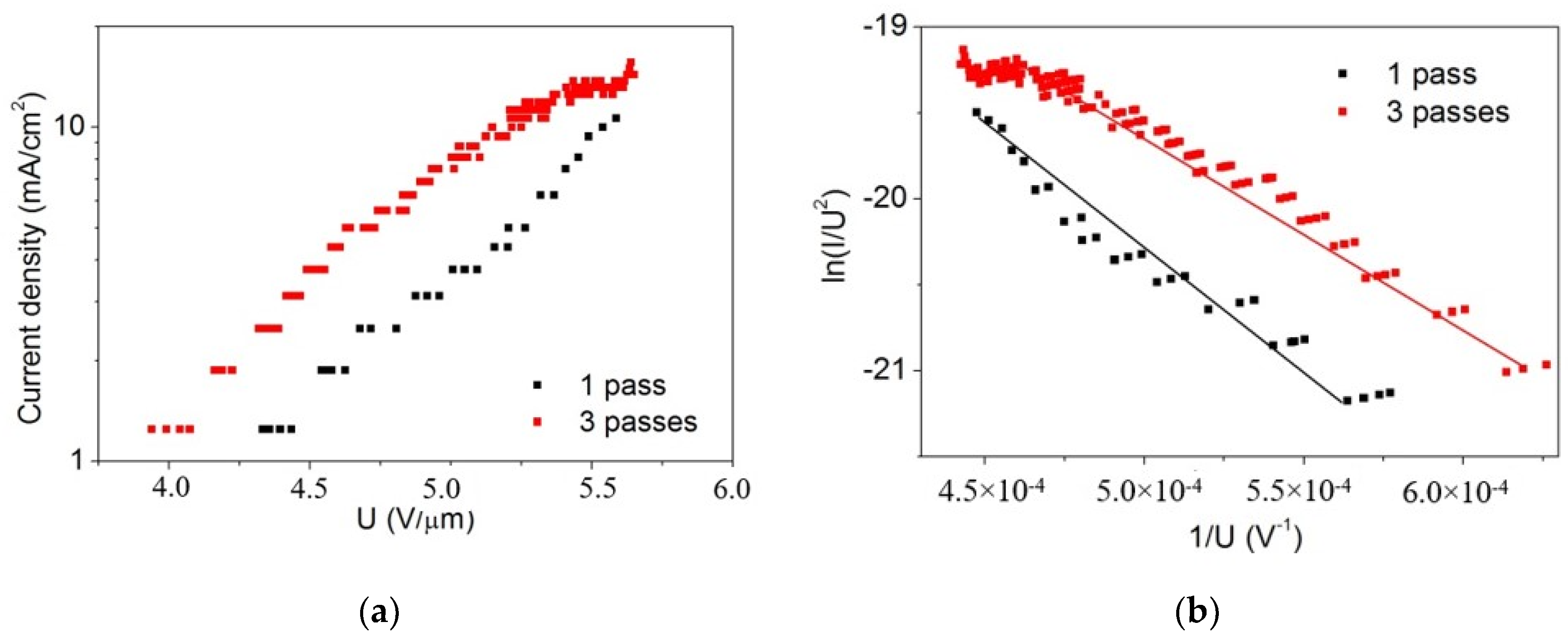Field Electron Emission from Crumpled CVD Graphene Patterns Printed via Laser-Induced Forward Transfer
Abstract
:1. Introduction
2. Materials and Methods
3. Results and Discussion
4. Conclusions
Author Contributions
Funding
Institutional Review Board Statement
Informed Consent Statement
Data Availability Statement
Acknowledgments
Conflicts of Interest
References
- Bonard, J.-M.; Kind, H.; Stöckli, T.; Nilsson, L.-O. Field emission from carbon nanotubes: The first five years. Solid State Electron. 2001, 45, 893–914. [Google Scholar] [CrossRef]
- Perales-Martinez, I.A.; Velásquez-García, L.F. Fully 3D-printed carbon nanotube field emission electron sources within-plane gate electrode. Nanotechnology 2019, 30, 495303. [Google Scholar] [CrossRef]
- Patra, A.; More, M.A.; Late, D.J.; Rout, C.S. Field emission applications of graphene-analogous two-dimensional materials: Recent developments and future perspectives. J. Mater. Chem. C 2021, 9, 11059. [Google Scholar] [CrossRef]
- Kianinia, M.; Xu, Z.-Q.; Toth, M.; Aharonovich, I. Quantum emitters in 2D materials: Emitter engineering, photophysics, and integration in photonic nanostructures. Appl. Phys. Rev. 2022, 9, 011306. [Google Scholar] [CrossRef]
- Novoselov, K.S.; Geim, A.K.; Morozov, S.V.; Jiang, D.; Zhang, Y.; Dubonos, S.V.; Grigorieva, I.V.; Firsov, A.A. Electric Field Effect in Atomically Thin Carbon Films. Science 2004, 306, 666. [Google Scholar] [CrossRef] [Green Version]
- Koh, A.T.T.; Foong, Y.M.; Pan, L.; Sun, Z.; Chua, D.H.C. Effective large-area free-standing graphene field emitters by electrophoretic deposition. Appl. Phys. Lett. 2012, 101, 183107. [Google Scholar] [CrossRef]
- Guo, Y.; Guo, W. Electronic and Field Emission Properties of Wrinkled Graphene. J. Phys. Chem. C 2013, 117, 692–696. [Google Scholar] [CrossRef]
- Wang, Y.; Yang, Y.; Zhao, Z.; Zhang, C.; Wu, Y. Local electron field emission study of two-dimensional carbon. Appl. Phys. Lett. 2013, 103, 033115. [Google Scholar] [CrossRef] [Green Version]
- Chen, L.; Yu, H.; Zhong, J.; Song, L.; Wu, J.; Su, W. Graphene field emitters: A review of fabrication, characterization and properties. Mater. Sci. Eng. B 2017, 220, 44–58. [Google Scholar] [CrossRef]
- Shao, X.; Srinivasan, A.; Ang, W.K.; Khursheed, A. A high-brightness large-diameter graphene coated point cathode field emission electron source. Nat. Commun. 2018, 9, 1288. [Google Scholar] [CrossRef] [PubMed] [Green Version]
- Wang, Q.; Zhang, Z.; Liao, Q.; Kang, Z.; Zhang, Y. Enhanced field emission properties of graphene-based cathodes fabricated by ultrasonic atomization spray. RSC Adv. 2018, 8, 16207–16213. [Google Scholar] [CrossRef] [Green Version]
- Ahsan, R.; Sakib, M.A.; Chae, H.U.; Kapadia, R. Performance Limits of Graphene Hot Electron Emission Photoemitters. Phys. Rev. Appl. 2020, 13, 024060. [Google Scholar] [CrossRef]
- Verma, V.P.; Das, S.; Lahiri, I.; Choi, W. Large-area graphene on polymer film for flexible and transparent anode in field emission device. Appl. Phys. Lett. 2010, 96, 203108. [Google Scholar] [CrossRef]
- Hwang, J.O.; Lee, D.H.; Kim, J.Y.; Han, T.H.; Kim, B.H.; Park, M.; No, K.; Kim, S.O. Vertical ZnO nanowires/graphene hybrids for transparent and flexible field emission. J. Mater. Chem. 2011, 21, 3432–3437. [Google Scholar] [CrossRef]
- Lahiri, I.; Verma, V.P.; Choi, W. An all-graphene based transparent and flexible field emission device. Carbon 2011, 49, 1614–1619. [Google Scholar] [CrossRef]
- Jeong, H.J.; Jeong, H.D.; Kim, H.Y.; Kim, S.H.; Kim, J.S.; Jeong, S.Y.; Han, J.T.; Lee, G.W. Flexible field emission from thermally welded chemically doped graphene thin films. Small 2012, 8, 272–280. [Google Scholar] [CrossRef]
- Iwai, Y.; Muramatsu, K.; Tsuboi, S.; Jyouzuka, A.; Nakamura, T.; Onizuka, Y.; Mimura, H. X-ray tube using a graphene flower cloth field emission cathode. Appl. Phys. Express 2013, 6, 105102. [Google Scholar] [CrossRef]
- Lee, S.W.; Lee, S.S.; Yang, E.H. A study on field emission characteristics of planar graphene layers obtained from a highly oriented pyrolyzed graphite block. Nanoscale Res. Lett. 2009, 4, 1218–1221. [Google Scholar] [CrossRef] [Green Version]
- Nakakubo, K.; Asaka, K.; Nakahara, H.; Saito, Y. Evolution of field electron emission pattern from multilayered graphene induced by structural change of edge. Appl. Phys. Express 2012, 4, 055101. [Google Scholar] [CrossRef]
- Behura, S.K.; Nayak, S.; Yang, Q.Q.; Hirose, A.; Jani, O. Chemical vapor deposited few-layer graphene as an electron field emitter. J. Nanosci. Nanotechnol. 2016, 16, 287–295. [Google Scholar] [CrossRef]
- Yusop, M.Z.; Kalita, G.; Yaakob, Y.; Takahashi, C.; Tanemur, M. Field emission properties of chemical vapor deposited individual graphene. Appl. Phys. Lett. 2014, 104, 093501. [Google Scholar] [CrossRef]
- Kleshch, V.I.; Bandurin, D.A.; Serbun, P.; Ismagilov, R.R.; Lutzenkirchen-Hecht, D.; Muller, G.; Obraztsov, A.N. Field electron emission from CVD nanocarbon films containing scrolled graphene structures. Status Solidi B 2018, 255, 1700270. [Google Scholar] [CrossRef]
- Wu, Z.S.; Pei, S.F.; Ren, W.C.; Tang, D.M.; Gao, L.B.; Liu, B.L.; Li, F.; Liu, C.; Cheng, H.M. Field emission of single-layer graphene films prepared by electrophoretic deposition. Adv. Mater. 2009, 21, 1756–1760. [Google Scholar] [CrossRef]
- Jeong, H.J.; Kim, H.Y.; Jeong, H.D.; Jeong, S.Y.; Han, J.T.; Lee, G.W. Arrays of vertically aligned tubular-structured graphene for flexible field emitters. J. Mater. Chem. 2012, 22, 11277–11283. [Google Scholar] [CrossRef]
- Qian, M.; Feng, T.; Ding, H.; Lin, L.F.; Li, H.B.; Chen, Y.W.; Su, Z. Electron field emission from screen-printed graphene films. Nanotechnology 2009, 20, 425702. [Google Scholar] [CrossRef]
- Wang, W.L.; Qin, X.Z.; Xu, N.S.; Li, Z.B. Field electron emission characteristic of graphene. J. Appl. Phys. 2011, 109, 044304. [Google Scholar] [CrossRef] [Green Version]
- Malesevic, D.A.; Kemps, R.; Vanhulsel, A.; Chowdhury, M.P.; Volodin, A.; Van Haesendonck, C. Field emission from vertically aligned few-layer praphene. J. Appl. Phys. 2008, 104, 084301. [Google Scholar] [CrossRef]
- Serra, P.; Piqué, A. Laser-Induced Forward Transfer: Fundamentals and Applications. Adv. Mater. Technol. 2019, 4, 1800099. [Google Scholar] [CrossRef] [Green Version]
- Delaporte, P.; Alloncle, A.-P. [INVITED] Laser-induced forward transfer: A high resolution additive manufacturing technology. Opt. Laser Technol. 2016, 78, 33–41. [Google Scholar] [CrossRef]
- Papazoglou, S.; Zergioti, I. Laser Induced Forward Transfer (LIFT) of nano-micro patterns for sensor applications. Microelectron. Eng. 2017, 182, 25–34. [Google Scholar] [CrossRef]
- Arutyunyan, N.R.; Komlenok, M.S.; Kononenko, T.V.; Dezhkina, M.A.; Popovich, A.F.; Konov, V.I. Printing of single-wall carbon nanotubes via blister-based laser-induced forward transfer. Laser Sci. 2019, 29, 026001. [Google Scholar] [CrossRef]
- Dezhkina, M.A.; Komlenok, M.S.; Pivovarov, P.A.; Rybin, M.G.; Arutyunyan, N.R.; Popovich, A.F.; Obraztsova, E.D.; Konov, V.I. Blister-based laser-induced forward transfer of 1D and 2D carbon nanomaterials. J. Phys. Conf. Ser. 2020, 1571, 012007. [Google Scholar] [CrossRef]
- Komlenok, M.S.; Kudryavtsev, O.S.; Pasternak, D.G.; Vlasov, I.I.; Konov, V.I. Blister-Based Laser-Induced Forward Transfer of Luminescent Diamond Nanoparticles. Phys. Status Solidi A 2021, 218, 2000269. [Google Scholar] [CrossRef]
- Komlenok, M.S.; Kudryavtsev, O.S.; Pasternak, D.G.; Vlasov, I.I.; Konov, V.I. Laser printing of diamond nanoparticles with luminescent SiV centers. Comput. Opt. 2021, 45, 860–864. [Google Scholar] [CrossRef]
- Smits, E.C.P.; Walter, A.; de Leeuw, D.M.; Asadi, K. Laser induced forward transfer of graphene. Appl. Phys. Lett. 2017, 111, 173101. [Google Scholar] [CrossRef]
- Chang-Jian, S.K.; Ho, J.R.; Cheng, J.J.; Sung, C.K. Fabrication of carbon nanotube field emission cathodes in patterns by a laser transfer method. Nanotechnology 2006, 17, 1184–1187. [Google Scholar] [CrossRef]
- Komlenok, M.S.; Pivovarov, P.A.; Dezhkina, M.A.; Rybin, M.G.; Savin, S.S.; Obraztsova, E.D.; Konov, V.I. Printing of Crumpled CVD Graphene via Blister-Based Laser-Induced Forward Transfer. Nanomaterials 2020, 10, 1103. [Google Scholar] [CrossRef] [PubMed]
- Rybin, M.G.; Islamova, V.R.; Obraztsova, E.A.; Obraztsova, E.D. Modification of graphene electronic properties via controllable gas-phase doping with copper chloride. Appl. Phys. Lett. 2018, 112, 033107. [Google Scholar] [CrossRef]
- Kondrashov, I.; Komlenok, M.; Pivovarov, P.; Savin, S.; Obraztsova, E.; Rybin, M. Preparation of Copper Surface for the Synthesis of Single-Layer Graphene. Nanomaterials 2021, 11, 1071. [Google Scholar] [CrossRef]
- Ferralis, N. Probing mechanical properties of graphene with Raman spectroscopy. J. Mater. Sci. 2010, 45, 5135–5149. [Google Scholar] [CrossRef] [Green Version]
- Sveningsson, M.; Morjan, R.E.; Nerushev, O.A.; Campbell, E.E.; Malsch, D.; Schaefer, J.A. Highly efficient electron field emission from decorated multiwalled carbon nanotube films. Appl. Phys. Lett. 2004, 85, 4487–4489. [Google Scholar] [CrossRef]
- Jeong, H.J.; Jeong, H.D.; Kim, H.Y.; Jeong, S.Y.; Han, J.T.; Lee, G.W. Self-organized graphene nanosheets with corrugated, ordered tip structures for high-performance flexible field emission. Small 2013, 9, 2182–2188. [Google Scholar] [CrossRef]
- Deng, J.H.; Wu, S.L.; Yang, Y.M.; Zheng, R.T.; Cheng, G.A. Fabricating vertically aligned ultrathin graphenenanosheets without any catalyst using rf sputtering deposition. Nucl. Instrum. Methods Phys. Res. Sect. B Beam Interact. Mater. At. 2013, 307, 177–180. [Google Scholar] [CrossRef]
- Yang, K.; Liu, J.; Jiang, R.; Gong, Y.; Zeng, B.; Yang, J.; Chi, F.; Liu, L. Maximizing the Field Emission Performance of Graphene Arrays. Nanomaterials 2020, 10, 2003. [Google Scholar] [CrossRef] [PubMed]






Publisher’s Note: MDPI stays neutral with regard to jurisdictional claims in published maps and institutional affiliations. |
© 2022 by the authors. Licensee MDPI, Basel, Switzerland. This article is an open access article distributed under the terms and conditions of the Creative Commons Attribution (CC BY) license (https://creativecommons.org/licenses/by/4.0/).
Share and Cite
Komlenok, M.; Kurochitsky, N.; Pivovarov, P.; Rybin, M.; Obraztsova, E. Field Electron Emission from Crumpled CVD Graphene Patterns Printed via Laser-Induced Forward Transfer. Nanomaterials 2022, 12, 1934. https://doi.org/10.3390/nano12111934
Komlenok M, Kurochitsky N, Pivovarov P, Rybin M, Obraztsova E. Field Electron Emission from Crumpled CVD Graphene Patterns Printed via Laser-Induced Forward Transfer. Nanomaterials. 2022; 12(11):1934. https://doi.org/10.3390/nano12111934
Chicago/Turabian StyleKomlenok, Maxim, Nikolay Kurochitsky, Pavel Pivovarov, Maxim Rybin, and Elena Obraztsova. 2022. "Field Electron Emission from Crumpled CVD Graphene Patterns Printed via Laser-Induced Forward Transfer" Nanomaterials 12, no. 11: 1934. https://doi.org/10.3390/nano12111934
APA StyleKomlenok, M., Kurochitsky, N., Pivovarov, P., Rybin, M., & Obraztsova, E. (2022). Field Electron Emission from Crumpled CVD Graphene Patterns Printed via Laser-Induced Forward Transfer. Nanomaterials, 12(11), 1934. https://doi.org/10.3390/nano12111934






